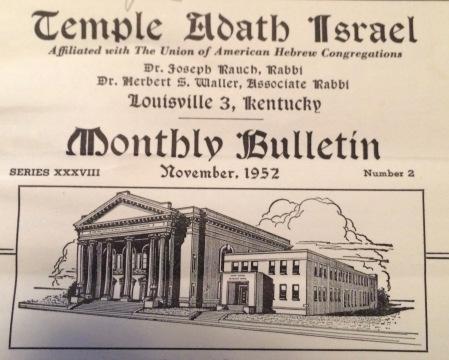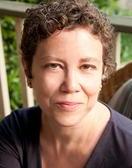
Yesterday, I drove my father to the house where he was born, for our annual Thanksgiving gathering. I woke early this morning and started sifting through old photos and letters. I kept returning to one yellowed pamphlet: the November 1952 bulletin from Temple Adath Israel in Louisville, Kentucky. The bulletin provides a snapshot of the community led by Rabbi Joseph Rauch, who was my great-uncle, and a pioneer in interfaith relations. Reading through this bulletin from a Thanksgiving season 64 years ago, I began to understand how extraordinary his work was, even by the standards of today. And right about now, in this very dark season in America, seems a good time to study how he went about weaving the social fabric.
But first, a little Jewish geography. My grandmother, Aimee Helen Rosenfelder, was born in Louisville, the youngest daughter of Rabbi Emanuel Michael Rosenfelder. Her sister Corinne married the brilliant young Rabbi Joseph Rauch, but she died very young. Uncle Joe (as my father called him) then married my grandmother’s other sister, Etta. So Uncle Joe married two of my grandmother’s sisters. He never had children, but my father–his nephew–spent the spring or summer of each year in Louisville, living in a great house with his many aunts and uncles, including Uncle Joe and Aunt Etta.
Joseph Rauch was a luminary in the progressive Jewish world. He was on the executive committee of the Central Conference of American Rabbis, president of the Hebrew Union College Alumni Association, and a founder of the World Union of Liberal Judaism. But beyond the Jewish world, he used his pulpit to advocate broadly for social justice and interfaith education. He took the unusual step of obtaining a doctorate from Southern Baptist Theological Seminary in Louisville. He is credited with helping to desegregate the Louisville library system, and he was an original panelist, alongside Christian clergy, on “The Moral Side of the News,’ which remains one of the longest-running public affairs programs in broadcast history.

Rabbi Joseph Rauch
The November 1952 temple bulletin I happened to find today in a shoebox is a testament to his interfaith work, and contains the following rather remarkable items:
- A report that Rosh Hashanah, Yom Kippur, and Sukkoth services at Adath Israel aired on Louisville television stations.
- A thank you letter from the local Methodist church for welcoming over 100 church members to a Sukkoth celebration at the temple.
- A proposal by Dr. Rauch (as he was known to his congregation) and one Sister Clara Frances to rename an alley that passes behind the temple, Nazareth College, First Unitarian Church, and Calvary Episcopal Church. The name they proposed: Interfaith Lane.
- An invitation to join Dr. Rauch for a weekly adult education series in November including the following topics: “Introduction to the Religions of the World,” “Your and My Religion,” “How Much of it do we Share with Christians,” and “How Much of it do we Share with Mohammedans.”
- An address by a University of Louisville exchange student from India, Naresh Shah.
- Dr. Rauch’s recent addresses at four different Protestant churches.
- Regular sermon topics, including “Religion in the public schools,” and “We need a world Thanksgiving.”
- A detailed curriculum for the children’s religious education program at the temple, including an entire course on “Comparative Religion.”
In the midst of the current season of interfaith Thanksgiving services, this little bulletin speaks of a deeper level of interfaith engagement, a level we urgently need now. We need entire congregations welcoming each other, not just once a year, but on a regular basis. We need more interfaith education for all adults, and for all our children. We need to work together, to protect this vision of intellectual engagement and mutual support across religious lines.


